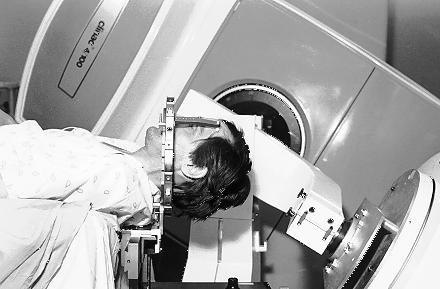Groundbreaking procedure aims to ease epileptic seizures

Patient Kevin Stonesifer last week became the first to undergo treatment of a type of epilepsy using VUMC's photon knife.
Vanderbilt University Medical Center neurosurgeons have for the first time used a computerized photon knife to treat a common type of epilepsy associated with hippocampal sclerosis.
By testing the photon knife ‹ in operation at VUMC since 1987 ‹ in this new way, surgeons hope to alleviate the often violent seizures associated with epilepsy without subjecting patients to the invasiveness of the current standard treatment.
Located in the temporal region of the brain, the hippocampus is responsible for a certain type of epilepsy which sometimes does not respond to treatment with drugs.
Two weeks ago, Kevin Stonesifer, a U.S. Postal Service employee, became the first patient to undergo the procedure for hippocampal sclerosis.
"The seizures interfered with my work and my life," said Stonesifer. "I was just tired of having to have other people do things for me."
Stonesifer had seizures when he was very young, but they disappeared until he was struck on the head while serving in the U.S. Marine Corps in 1980. He has been plagued by them ever since, leading to problems at work and the wreck of one car.
Dr. Bassel W. Abou-Khalil, associate professor of Neurology, is the principal investigator of the study, which compares photon knife and standard surgery. He began seeing Stonesifer approximately six months ago.
"When medications fail to control seizures, the standard therapy is the surgical removal of the hippocampus," said Abou-Khalil. "That is an open brain surgery whereby a piece of the skull is removed and the brain is exposed, which carries quite a few risks. The photon knife procedure will hopefully have the same results with much less risk."
The photon knife procedure's lack of invasiveness compared with traditional open surgery is what has made it an attractive option in treating hippocampal sclerosis, said Robert J. Maciunas, associate professor of Neurological Surgery. Maciunas and his team, which include Dr. Bennett Blumenkopf, associate professor of Neurosurgery, Dr. Peter Konrad, resident in Neurosurgery, Dr. Anthony J. Cmelak, assistant professor of Radiology and Radiological Sciences, and Dr. George S. Allen, William F. Meacham Professor and Chair of Neurological Surgery, performed the procedure.
"The photon knife involves no dissection of the brain, no injury to surrounding structures and no blood loss, which is not the case with traditional surgical procedures."
The photon knife works by focusing beams of photons to a single point from thousands of different angles by using multiple convergent arcs.
During this type of procedure a stereotactic frame, or halo, is first fitted to the patient's head so that the physicians will have a reference point with which to take precise measurements.
These measurements are made by using CT and MRI scans to create a precise three-dimensional map of the patient's brain. This model is then used to plan the different angles at which the photon knife will be used. In Stonesifer's procedure, thousands of different beams were all focused on one spot in his brain.
"The accuracy of the system from a mechanical point of view is sub-millimetric," said Maciunas. "The target receives a high level of radiation in a single dose while the surrounding tissues receives only a tiny dose of radiation."
The collimated beams of the photon knife are created using a linear accelerator which produces 4 MEV photons. The energy is then harnessed and formed into columns of x-rays.
Though the surgery itself takes hours to perform, the effects can take a little more time to develop.
"The effects should begin to appear within 6-9 months but we expect to wait 2 years to have final results," said Abou-Khalil. "The open surgery had about a 70 percent rate of patients that were seizure-free and we hope to have about that same number."
Stonesifer hopes the procedure will ease his seizures.
"I haven't felt any effects yet, but I hope that this will end the seizures so that I can get back to my life."













